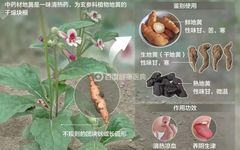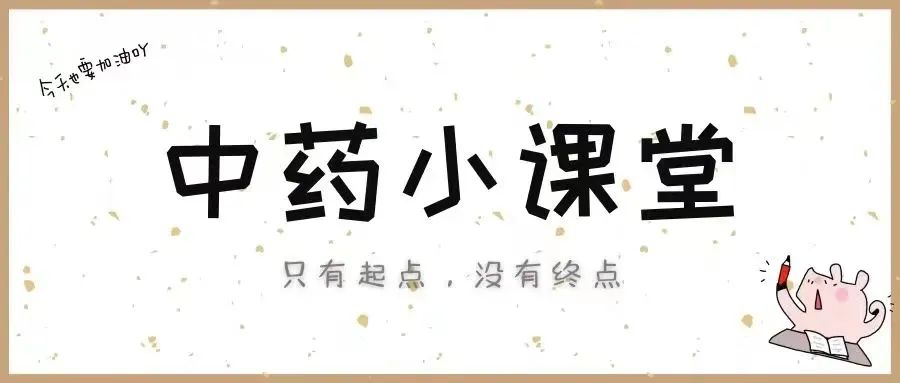
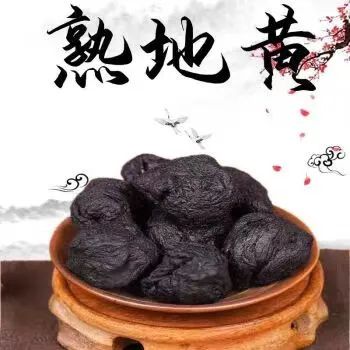
01
Introduction
Shu Di Huang (Rehmannia Glutinosa) is a heat-clearing herb, derived from the dried tuber of the plant belonging to the Scrophulariaceae family. It is a processed product of Sheng Di Huang (Raw Rehmannia). Shu Di Huang has a sweet taste and a warm nature, and it is associated with the liver and kidney meridians. Its chemical composition is similar to that of Sheng Di Huang, primarily containing phenylethanoid glycosides such as catalpol, along with monosaccharides, amino acids, and vitamin A-like substances. It is known for its ability to nourish blood, enrich yin, and replenish essence and marrow. The main production areas include Liaoning, Henan, Shandong, Jiangsu, and Hubei. The medicinal part of Shu Di Huang is the fresh or dried tuber of the Rehmannia plant.
02
Differences and Similarities between Fresh, Raw, and Cooked Rehmannia
All three herbs can nourish yin and generate fluids, treating symptoms of yin deficiency and fluid depletion.
1. Xian Di Huang (Fresh Rehmannia) is sweet and bitter with a cold nature. Although its ability to nourish yin is weaker, it has less greasy nature, excelling in clearing heat and cooling the blood, often used for treating blood heat and yin deficiency with significant heat.
2. Sheng Di Huang (Raw Rehmannia) is sweet and cold, slightly less effective in clearing heat and cooling the blood compared to Xian Di Huang, but stronger in nourishing yin and generating fluids, with a less greasy nature, suitable for treating heat entering the blood and yin deficiency with fever, though its nourishing power is inferior to Shu Di Huang.
3. Shu Di Huang is sweet and slightly warm, with a significant greasy nature, specifically entering the liver and kidney to effectively nourish blood and enrich yin, replenishing essence and marrow, excelling in treating blood deficiency and liver-kidney deficiency syndromes.
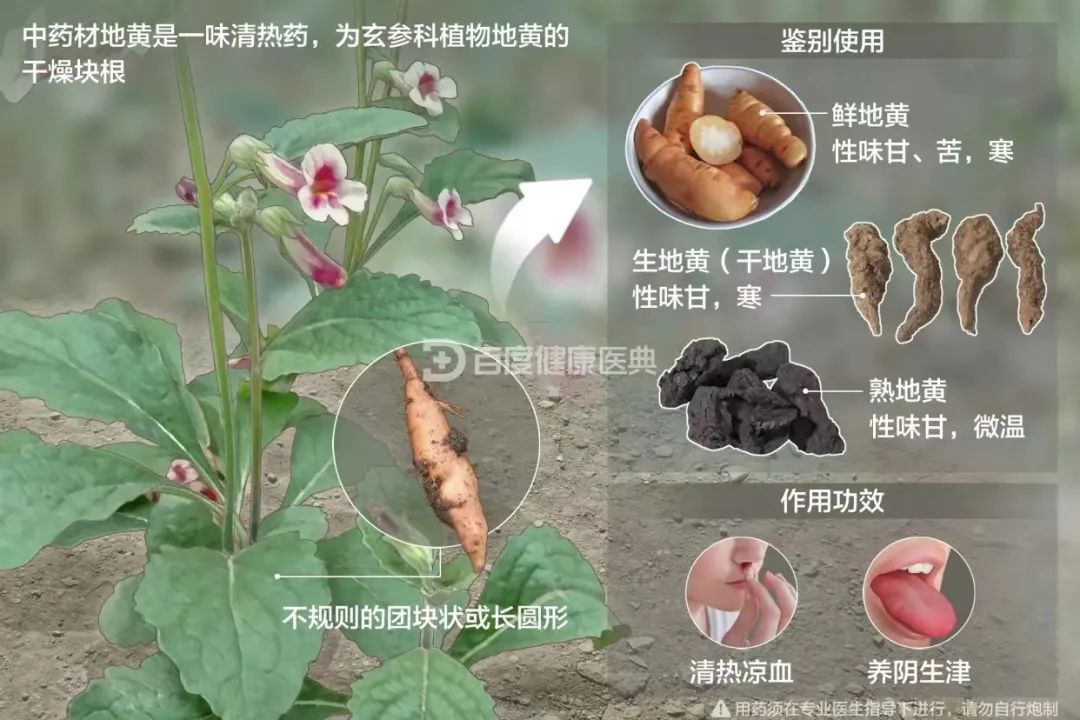
03
Characteristics of the Medicinal Part of Shu Di Huang
It appears as irregular chunks or fragments, varying in size and thickness. The surface is dark black with a glossy finish and has a high viscosity. The texture is soft yet resilient, not easily broken, with a black and glossy cross-section. It has a faint aroma and a sweet taste.
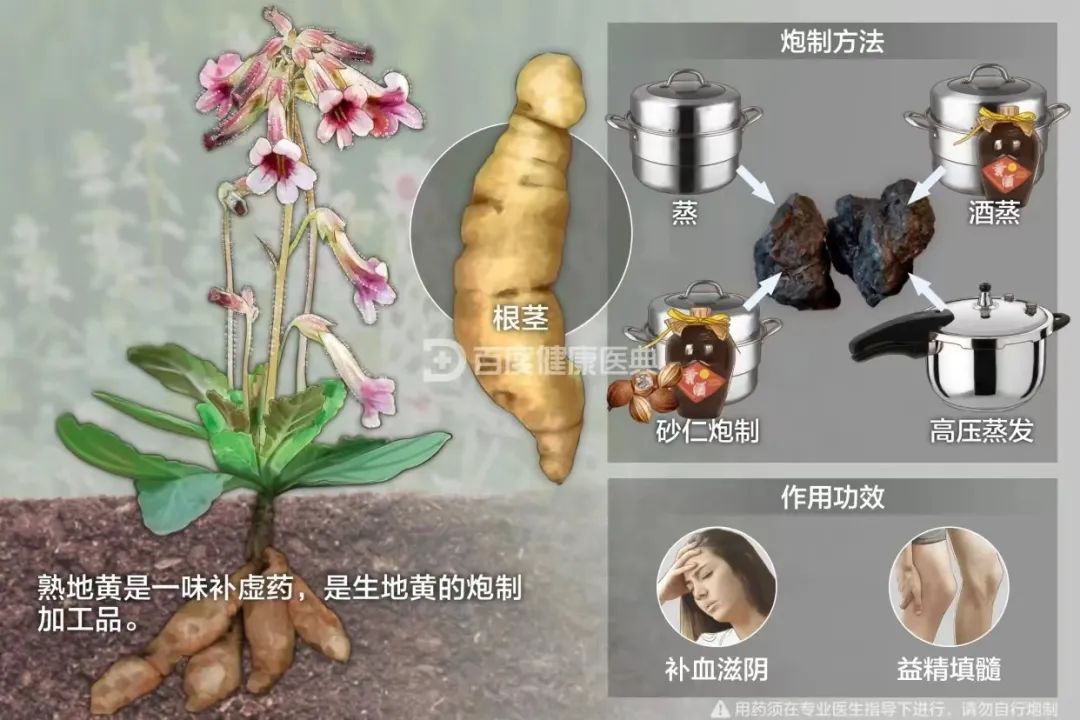
04
Main Efficacy and Clinical Applications of Shu Di Huang
Shu Di Huang is used for blood deficiency leading to pale complexion, palpitations, irregular menstruation, excessive bleeding, liver and kidney yin deficiency, soreness of the lower back and knees, tidal fever, night sweats, seminal emission, internal heat and thirst, dizziness, tinnitus, and premature graying of hair.
1. Treatment of Blood Deficiency: For symptoms such as pale complexion, dizziness, palpitations, irregular menstruation, or amenorrhea, it is often used in conjunction with Dang Gui (Angelica Sinensis).
2. Treatment of Liver and Kidney Yin Deficiency: For symptoms like soreness of the lower back and knees, dizziness, blurred vision, tinnitus, tidal fever, night sweats, seminal emission, and internal heat and thirst, it is commonly combined with Shan Yao (Chinese Yam), Shan Zhu Yu (Cornus), and Mu Dan Pi (Moutan Peony Root).
It is also used for premature graying of hair due to kidney and blood deficiency, often combined with He Shou Wu (Fo-Ti).
05
Common Medicinal Recipes Using Shu Di Huang
For palpitations, insomnia, dizziness, and light menstrual flow due to blood deficiency, as well as seminal emission, night sweats, hair loss, and soreness of the lower back and knees due to kidney yin deficiency:
15g of Shu Di Huang, 50g of japonica rice, and an appropriate amount of rock sugar.
Slice Shu Di Huang and wrap it in gauze, simmering it over low heat until the decoction turns brown, then add the japonica rice to cook. After cooking, remove the Shu Di Huang and add rock sugar to dissolve.
For both qi and blood deficiency, pale complexion, poor appetite, and fatigue:
5g each of Dang Shen (Codonopsis), Fu Ling (Poria), Bai Zhu (White Atractylodes), Zhi Gan Cao (Honey-fried Licorice), Shu Di Huang, and Bai Shao (White Peony), 3g of Dang Gui, 6g of Huang Qi (Astragalus), 750g of pork, 750g of pork bones, and 1 whole chicken.
Wash and slice the pork, crush the pork bones. Wrap the eight herbal ingredients in gauze, and add the chicken, pork, pork bones, and the herb bundle into a pot with an appropriate amount of water. Simmer until the chicken is tender and the meat falls off the bone, then remove the herb bundle. Add ginger, scallions, cooking wine, and salt to taste, and serve warm.
For hair loss, forgetfulness, and infertility due to liver and kidney deficiency:
60g each of Shu Di Huang and Gou Qi Zi (Goji Berries), 6g of Chen Xiang (Agarwood), and 1L of white liquor. Soak the herbs in the liquor, seal, and let it sit for 10 days before consumption.
Note: The use of Chinese medicinal materials must be based on syndrome differentiation and should be guided by a qualified TCM practitioner. Self-medication or reliance on folk remedies and advertisements is not advisable.
06
Formulations Containing Shu Di Huang
1. Si Wu Tang
Nourishes blood and regulates menstruation. It is used for blood deficiency stagnation syndrome, characterized by dizziness, palpitations, pallor, irregular menstruation, abdominal pain, and possibly masses or hard lumps. The tongue is pale, and the pulse is thin and wiry or thin and rough.
2. Ba Zhen Tang
Tonifies qi and nourishes blood. It is used for qi and blood deficiency syndrome, characterized by pale or sallow complexion, dizziness, fatigue, shortness of breath, palpitations, reduced appetite, pale tongue with thin white coating, and weak or vacuous pulse.
3. Liu Wei Di Huang Wan
Nourishes yin and tonifies the kidneys. It is used for kidney yin deficiency, characterized by dizziness, tinnitus, soreness of the lower back and knees, tidal fever, night sweats, and thirst.
4. Zhi Bai Di Huang Wan
Nourishes yin and clears heat. It is used for yin deficiency with excess heat, characterized by tidal fever, night sweats, dry mouth and throat, tinnitus, and short red urine.
5. Ming Mu Di Huang Wan
Nourishes the kidneys, benefits the liver, and brightens the eyes. It is used for liver and kidney yin deficiency, characterized by dry eyes, photophobia, blurred vision, and tearing in the wind.
6. Da Bu Yin Wan
Nourishes yin and clears heat. It is used for yin deficiency with excess heat, characterized by tidal fever, night sweats, coughing up blood, and tinnitus.
7. You Gui Wan
Warms and tonifies kidney yang, replenishing essence and stopping leakage. It is used for kidney yang deficiency, characterized by coldness in the lower back and knees, fatigue, aversion to cold, impotence, and frequent clear urination.
07
Precautions
Indications
Suitable for individuals with symptoms of liver and kidney deficiency.
Contraindications
1. Shu Di Huang is warm in nature, thus should not be used in large amounts for those with external heat, internal heat, or excess heat syndromes.
2. Individuals with significant dampness, phlegm due to spleen deficiency, or abdominal distension due to qi stagnation should avoid it.
3. Shu Di Huang has a sticky nature that can hinder digestion; therefore, it should be avoided by those with qi stagnation, excessive phlegm, dampness, fullness, poor appetite, or loose stools. If used in large amounts for a long time, it is advisable to combine it with Chen Pi (Aged Tangerine Peel) or Sha Ren (Amomum) to prevent digestive issues.
4. It is not advisable to combine with Bai Luo Bo (White Radish), Jiu Cai (Leek), Xiao Bai (Garlic Chives), or Cong Bai (Scallions). Since Shu Di Huang is a yin-nourishing herb, it should not be used with herbs that disperse qi, as these may diminish its nourishing effects.
Other Precautions
Avoid using copper or iron utensils for decocting.
During the medication period, avoid cold, raw foods, and spicy, greasy foods.
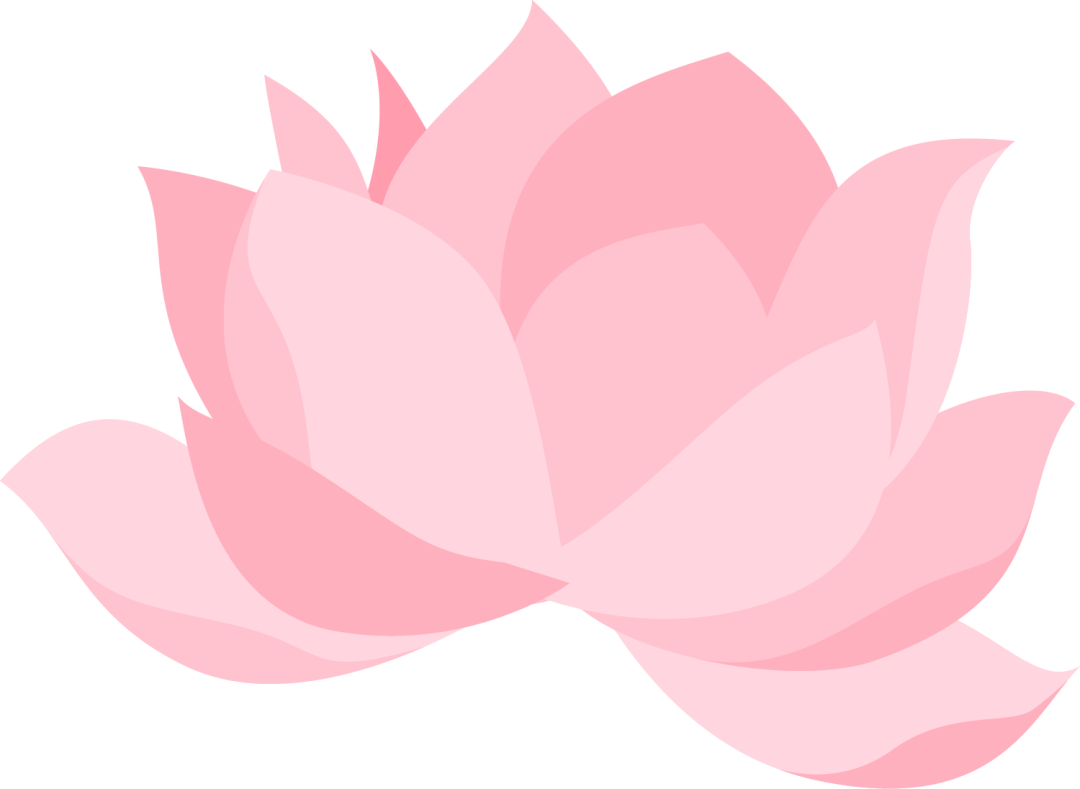
Text and Images | Internet
Editor | Zhao Jiangtao
Reviewers | Chang Hong, Lü Guohong


